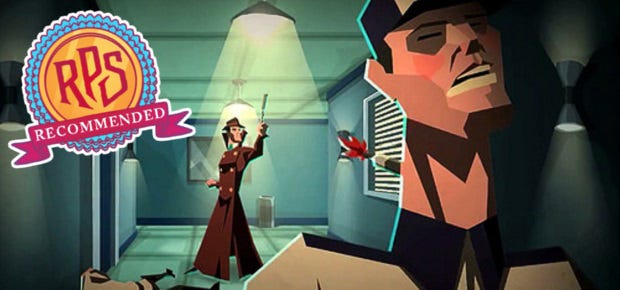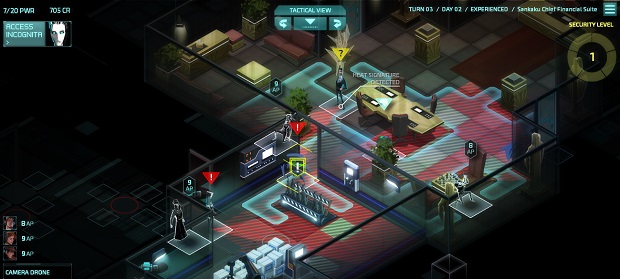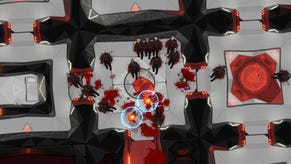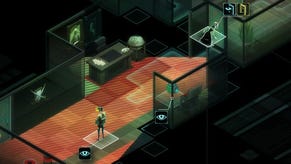Wot I Think: Invisible, Inc.
A sneaking masterpiece
Invisible, Inc. [official site] is a game of “tactical espionage” from the creators of Mark of the Ninja, immediately understandable as XCOM meets Mission Impossible. You control a tiny team of sleuths working to rob the procedurally-generated vaults, server farms and detention centres of four high-tech corporations. In just 72 hours you’ll be taking on a fittingly impossible mission, and failure is not an option. Here's wot I think.
Invisible, Inc. is the best turn-based strategy game I’ve played in years, in a time when we're spoiled for choice. Let’s start by talking about how it’s a stealth game with a solution to *the* problem with stealth games, which is the game deflating like a balloon the moment you’re spotted.
Here, stealth games almost always transition into terrible combat games. This is often followed by a chase, which would be agreeable except it’s not sustainable, so you’re only ever fleeing from surreal goldfish guards who assume that the hulking man squatting in a shadow was probably nothing untoward and your bungling burglar can attempt his fourth break-in.
Getting spotted in Invisible, Inc. is as electrifying as it is cinematic. You’re given the opportunity to exist in that heartbeat.
Let’s say a guard catches a member of your team hunched over an open safe. They aim their gun. You stop breathing. The game’s fantastic soundtrack even takes an interest, adding drums and additional instrumentation to the music. Finally, the building’s alarm increases, because in Invisible the alarm is a creeping threat rather than a ridiculous ON/OFF switch, something I’ve already made an entire, loved-up video about (though be warned, that’s footage from a pre-launch build).
Finally, control returns to you, and with the detachment of an MI6 operator solving his Sunday supplement’s chess puzzle, you wonder how you’re going to get out of this one.
Some sample solutions: you’re able to hide from a pointed gun if you do so by moving to an adjacent tile, so with careful positioning your agents can always slip around a corner or behind a desk; or maybe you just activate that agent’s optic camouflage and he simply vanishes in front of the stunned guard; maybe a second agent slips behind the guard and zaps him into unconsciousness, robbing his wallet and keycard to boot; maybe you use one of a dozen different items you might have liberated from a corp R&D facility.
But if you can’t slip away in these moments, failure has a charm all of its own. There are no drawn-out fights in Invisible, no hiding in a cupboard until the guards lose interest. Taking a bullet is instantaneous, and final, the agent concertina-ing to the ground and threatening a devastating loss to your campaign, just like in XCOM. Except here, in a superior system, losing an agent instantly generates a captivating, atmospheric decision tree, because you *can* save agents, but the cost is immense. You can drag them to the exit elevator, or try and locate a medkit. But that alarm’s still creeping up. Trying to be a hero could doom your whole team. Perhaps it’s best to just sneak over and grab the holographic cover projector they were carrying. Maybe their weapon, too. Sorry, Shalem. Those of us still walking have a business to run.
So being spotted in Invisible only ever results in your magnificent escape or untimely demise, et voila! The entire game is now stealthy, with no rubbish bits. But we’re not finished yet. Further allowing the developers to keep the game balanced atop a tightrope of tension is the Rewind button, a feature I wasn’t expecting to like but that won me over completely.
Depending on your difficulty setting you get 5, 3 or just 1 Rewind, each of which will take you back to the beginning of the last turn in a flash of white, as if someone on your team had a vision of what was coming. Obviously this can jump you back before you were spotted and allows the developers to be a little more surprising in their level generation, but it can also let you scout rooms and then time-hop back out of them to save you a turn.
Careful, though. This is the only tool that can reliably get you out of really deep trouble. Are you sure you want to spend it on anything mundae? And when you do get in trouble, the decision of when to spend a Rewind, and whether to use it multiple times, can lead to wonderful time-angst where you think if you rewind just once, you could probably beat up those three guards when they enter the room. Or you could rewind twice and be absolutely ready, but then you’ll have none left.
Choosing when to rewind is a good example of the constant calculation of risk vs. reward that keeps Invisible so interesting and engaging. Other examples of these wonderfully empowering decisions include what toys to buy at a nano-fabricator, when to flee each level and when to stick around, and when to split your team up to cover (read: rob) more ground. Any one of these calls can (and will) get your team killed, but that’s never annoying, as it can be in so many roguelikes, because the game you’re playing is so utterly solid.
Invisible had a strong spine of internal logic in its level randomisation and reward distribution when it first entered Early Access 16 months ago, which was when I first started losing evenings to it. You could spend action points to predict guard patrols, for example, and you quickly learned how much or how little money could be lining their pockets, that kind of thing. The game felt fair. After more than a year spent balancing and refining, the release build is just a joy. It’s balanced, sure, the interface offers perfect control, yes, but there are also four different corporations you can steal from, and in addition to each having its own look and soundtrack each also telegraphs what sort of security to expect. Robots? Guards? Ghosts in the machine?
From campaign to campaign you’ll fear some corps more than others, because Invisible draws its replayability from a varied catalogue of agents, items, cybernetic implants and hacking software. You have little control over what toys you’ll find, though. The game doesn’t let you do anything as boring as decide to go full-on hacking and bully the Sankaku robotics corporation. When you find a top-of-the-line tranquilizer rifle with drilling, armour-piercing darts, you can’t ignore it.
I’ll give a real example from my last campaign. I started with Nika, a close combat expert a lá Jason Bourne. Early on I broke into a cybernetics lab and the rest of my team locked down the room as Nika went under the robo-knife not once, but twice, emerging as someone who gained 11 action points from horrid robot legs whenever she knocked out a guard. We then went on a mission to get her a state of the art stun gun and she became a monster, knocking out a guard, moving, knocking another out, moving. But she was also moving faster than the rest of the team, which meant I had to try and find equipment to help everybody else keep up with her, as well as equipping them with medkits and new camoflage generators to replace the one she wore when it was recharging. They became something like a Formula 1 pit crew.
This is the game. You pick a starting team, you start making tough calls from the very first mission, your team evolves into a new configuration with its own strange synergies and terrible failings, you lead them to heroic success or equally-heroic failure over about six hours, you unlock a new starting configuration and you go again. One part roguelike, one part persistent strategy game, it’s an innovative combination and it works gloriously.
Anything else? Oh, yes. It looks and sounds absolutely charming. The hacking interface in particular deserves a mention. Spacebar toggles the world into wireframes, swaps the soundtrack out for a half-dozen synthesizers and pulls the camera back *ever so slightly*, with any devices you can hack displayed in cherry red. What could have been a cluttered interface instead becomes you playing two games in parallel, delighting each time you swap between them.
Everything’s this sweet. The voice acting, writing, music and art design is all held to the same high standard. You end up looking forward to everything. From starting a mission with no idea of what surrounds you, to discovering the reward at the end, to escaping via the exit teleporter, to hearing the chatter between your team on the world map. It’s all satisfying, surprising, colourful and utterly devoid of friction, letting you lose yourself in the puzzle, yes, but also the evocative imagery the game thrills in. Your agents plotting daring heists, working like a well-oiled machine to rob a vault, and leaving with as much high-tech equipment as they can stagger under.
Or the other side of the coin - your plans coming crashing down around you and your agents abandoning one another, each sprinting around the level, heedless of cameras and sound bugs and just looking for a way out, before one comes face to faceplate with a six foot tall, weaponised security drone.
What then? Time stops. You exist in that heartbeat. You reflect on the greed and stupidity that brought you to this moment as you desperately pan the camera around the map. There has to be a way out. This can’t be the end.
Maybe it is, and you have to click the button that sees Nika gunned down. Or maybe it’s not. Maybe on the other side of the map, Internationale can siphon enough power from the terminal she’s hiding behind to give you control of that robot, for just one turn. One turn for you to turn this whole situation around. But that’s for you to find out.
You should buy Invisible, Inc. because, like I said, I think it’s the best turn-based strategy game to come out in years. But you should love it because it’s a creative endeavour that offers such rich moments. Just don’t let this sneaking masterpiece slip you by.
Invisible, Inc. is available now.
























